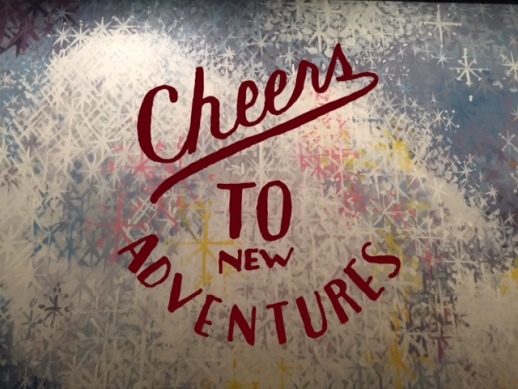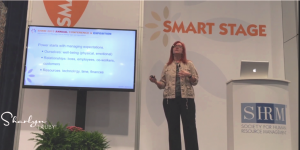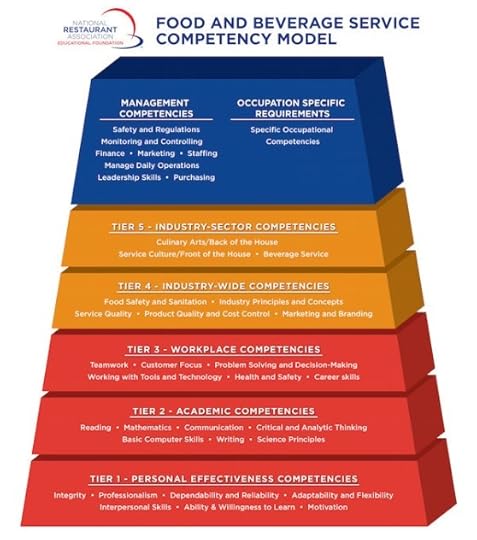Sharlyn J. Lauby's Blog, page 171
September 6, 2015
Labor Day 2015
Tomorrow is the Labor Day holiday in the United States. There appear to be lots of stories about how Labor Day started (you can check them out here and here.) Bottom line, Labor Day is to celebrate the American worker.
While the U.S. job market is improving – the unemployment rate fell to 5.1 percent – there are still many employment issues facing us. Employee engagement is in decline and employee wages aren’t keeping up with the cost of living. I’m thinking this Labor Day should be to celebrate everyone who has (1) been a worker, (2) is a worker, (3) wants to be a worker and (4) will be a worker in the future. Let’s make this year’s holiday about all of us and the past/present/future of work.
And if you’re looking for something delish to cook for the holiday, Here’s Alton Brown’s Burger of the Gods recipe. There’s some serious prep involved, but I wouldn’t expect anything less from AB. So enjoy the weekend and celebrate yourself. I’ll leave you with one of my favorite clips about Labor Day. Cheers!
The post Labor Day 2015 appeared first on hr bartender.






September 4, 2015
Employability Skills Provide Your Career Future – Friday Distraction
(Editor’s Note: Today’s post is brought to you by our friends at the National Restaurant Association Educational Foundation (NRAEF) . As the philanthropic foundation of the National Restaurant Association, the NRAEF works to attract, develop and retain professionals for the restaurant industry. Enjoy today’s post!)
Mr. Bartender and I recently went to see the movie “Vacation.” Mr. B says it’s a nice homage to National Lampoon’s original. I’ve never seen the 1983 version, so I’ll leave the comparisons to Chevy Chase fans everywhere. I mention the movie because there was a scene where the family visits Debbie Griswold’s alma mater. On the day of their visit, her sorority is having a fun, obstacle course event for charity.
It reminded me of the days when my employer held restaurant games. Employees would participate in table setting competitions and wine service relays. They had great fun and it was for a worthy cause.
But the games did more than provide a little fundraising and entertainment. It taught employees skills like teamwork, planning, and time management. Employees worked together to develop winning strategies. And they had to work with other employees they didn’t see every day, which built working relationships.
These employability skills are critical to our future success. That’s why they’re a part of the Food and Beverage Service Competency Model, developed by theNational Restaurant Association Educational Foundation (NRAEF).
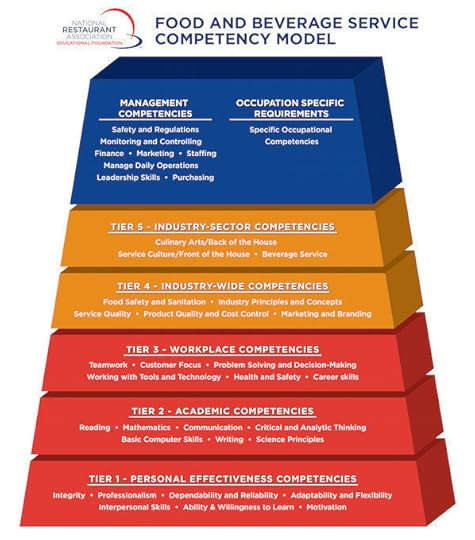
As a human resources professional, we look for employability skills in the hiring process. We also look for the same skills when considering employees for transfers and promotions. It’s one of the reasons that the NRAEF created the Food and Beverage Service Competency Model. More than 80 percent of current employees agree that restaurants provide opportunity for people to succeed based on their own hard work.
Employability Skills Provide Your Career Future #ChooseRestaurants
Click To Tweet
Almost any career path can include the employability skills found in the restaurant and foodservice industry. Positions range from traditional titles of bartender, waiter and chef, to recruiter, marketing manager, supply chain supervisor, payroll clerk and business owner.
Just about anything someone wants to do can be found within in the restaurant and foodservice industry. So pay attention – your career future is all about employability skills.
The post Employability Skills Provide Your Career Future – Friday Distraction appeared first on hr bartender.






September 3, 2015
Convincing the CEO Isn’t as Difficult As You Think
I’ve mentioned a couple of times that I’m going to London for Tucana’s HR Change & Transformation conference on October 13-14, 2015. The theme this year is HR innovation for competitive advantage. I’m very excited about attending and being a part of this conversation. Some of the sessions are focused on agile HR, salesforce transformation and labor forecasting – topics I don’t typically see on a human resources conference agenda. It’s very refreshing.
In mentioning my upcoming trip to a colleague, I received an interesting reply.
Good luck! Not to be a downer, but unless the CEO supports HR, you can throw change and transformation out the window.
I totally agree. Change is futile if it’s not supported within the organization. A couple of years ago, I had the privilege of interviewing Dr. John Kotter about creating organizational change. If you haven’t seen the interview, you can check it out here. Getting support for any change effort is important and essential for success.
But I want to add a couple of things I’ve learned over the years about getting organizational support:
First, I’ve never met a CEO that wasn’t willing to listen to an idea that would improve the bottom-line. When we talk about initiating change, does the idea improve the bottom-line? And if so, how?
Second, when we talk about creating change and needing support to make change happen, we have to pitch those ideas in terms that everyone understands. Bottom-line results? Everyone understands.
I think I’ve mentioned this story before but it fits so well here. In one of my first HR jobs, I would attend a weekly manager meeting. During the meeting, we would go around the table and discuss the projects we were working on and the resources we needed from the organization. Every week, I would watch other managers talk about their projects and get the resources they asked for. When it came my turn, I would explain my project and the resources I needed. Sometimes I would get the support I was looking for but most of the time I didn’t. It was frustrating (to put it mildly.)
So I decided that I needed to figure out what I was doing wrong. In thinking about what the other managers did, I realized that they talked about their projects in terms of bottom-line results. They used metrics and numbers and return on investment. When I talked about projects, I expressed results in terms of what would make the employees feel good.
Now, don’t get me wrong. Senior management does care about employees and their engagement with the organization. But I found that, when I was able to talk about what the employees want in numerical form, I was able to get project and resources approved. That’s why human resources professionals need to:
Understand the key industry metrics for your organization. Every industry has them. They are the metrics that set your organization apart from the competition.
Learn how to calculate internal metrics. One of the must-haves on my business book shelf is “How to Measure Human Resource Management” by Jac Fitz-enz. Don’t know how to calculate something? This book will show you.
Keep current with external business trends. Indicators such as unemployment rates, demographics, etc. factor into everyday business decisions. Find good sources for business data and read them regularly.
Convincing the CEO and senior management to embrace change doesn’t have to be hard. It does take staying on top of business trends, which we should be doing anyway. And it takes communicating the change in a way that everyone understands, the language of bottom-line results.
Oh, and P.S. If you’re going to be at Tucana’s HR Change and Transformation next month, let me know! It would be great to connect in person. Still need to register? Use the code CT1502 to receive a ₤150 discount.
The post Convincing the CEO Isn’t as Difficult As You Think appeared first on hr bartender.






September 1, 2015
Your Company Needs an Engagement Strategy
(Editor’s Note: Today’s post is brought to you by our friends at HireRight . They deliver global background checks, drug testing and employment verification services to help companies hire the right candidate. They just released their next generation Applicant Center , the industry’s only background check portal designed to increase recruiting efficiency and decrease time to hire. Enjoy the post!)
My new favorite line is “Common sense isn’t always common practice.” Employee engagement is a clear example. As much as we talk about it, there are companies that don’t have a defined strategy. It’s not because they don’t want engaged employees. Often it’s because they don’t realize how engagement would improve if they had a dedicated conversation and developed a strategy.
We wouldn’t think of not having a marketing strategy or a sales strategy. Organizations have those strategies because they know it helps them deliver results to the bottom-line. Well, employee engagement brings results to the bottom-line in several ways:
Engaged employees are less likely to leave the organization. We already know that engaged employees are happier and more satisfied with their work. This leads to increased productivity. These qualities point to better retention. According to an article in Forbes, highly engaged employees are 87% less likely to leave their company. Greater retention has a positive impact on the bottom-line, both in terms of consistent customer service and reduced employee replacement expenses.
Engaged employees become evangelists for your organization. Currently engaged employees will refer their friends and colleagues for jobs. (Side note: Former engaged employees will also refer their friends and colleagues for jobs. Sometimes a totally engaged employee will have to resign because their significant other received a promotion in another state or to take care of a family member.) This reduces cost per hire and improves quality of hire.
Both current and former engaged employees will refer customers. It goes without saying that if employees love their work and feel connected to the company, they will want it to be successful. That means when opportunities present themselves to promote the company, they’ll do it!
Engaged employees directly impact the bottom-line. New York Times best-selling author Kevin Kruse, in an article for Forbes, points out that highly profitable companies have 50 percent more engaged employees and teams with high levels of engagement beat average revenue growth by 1 percent. Engagement isn’t just some feel good activity. It has a direct connection to organizational growth and profitability.
The actual mechanics of developing an engagement strategy are similar to other strategies. BUT (yes, I had to throw a “but” in there) remember, when you’re having discussions about your engagement strategy, keep these three things in mind.
Engagement isn’t a “one size fits all” activity. There might be smaller sub-strategies for different work groups. For example, managers (especially those in the company’s succession plan) might need different forms of training and recognition. Contingent workers (freelancers, contractors and on-call employees) should be included in the engagement strategy. Oh, and last but certainly not least, think about what it takes to keep human resources engaged.
Engagement activities should be varied. No single activity will create engagement. Consider individual activities such as stay interviews and mentoring. There are benefits to conducting larger scale initiatives like employee surveys and volunteer activities. Well-being and professional development programs provide ongoing engagement.
Engagement activities need to be measured for effectiveness. The company’s sales and marketing activities are measured and evaluated. Engagement activities should be as well. Examples of engagement measurements include the Gallup Q12 and people analytics data (e.g., discretionary effort, people networks, meetings, etc.)
If you want to learn more about creating an effective engagement strategy, join me and the HireRight team for a webinar “Keeping the Best: 5 Strategies for Engaging and Retaining Your Talent” on Wednesday, September 16, 2015. Registration details can be found here.
Organizations that dedicate their resources to developing an engagement strategy will see a more productive workforce and an improved bottom-line. What’s good for talent is good for the business.
The post Your Company Needs an Engagement Strategy appeared first on hr bartender.






August 30, 2015
Developing HR Competencies – Ask #HR Bartender
This is a Catch-22 situation if I’ve ever seen one:
I was helping a friend with his job search. He is trying to obtain an entry level HR position. A position he found indicated the minimum education required was a high school diploma but 5 – 8 years of experience was necessary. Neither of us understood the logic. We do not know how a high school student can get that level of experience by the time they graduate. Could you please explain why this is common on most entry level HR positions?
I hate to say it, but this isn’t the first time I’ve heard of conflicting education and experience requirements in open positions. While we might not be able to change the company’s confusing requirements, there are some things to consider:
There’s “paid” and “unpaid” experience. We gain experience in many ways. Yes, some of it is through work. But we also can gain experience through our volunteer efforts. Think about all of the roles you’ve had and the experience you’ve gleaned as a result.
Don’t forget transferrable skills. Many very successful HR pros start their careers in other areas like finance, operations, and sales. If you have a background in another function, be prepared to talk about how that relates to the role you want in human resources.
Consider other entry level HR roles. There are many rewarding, fun, challenging, and well-paying jobs in organizations that support the traditional in-house human resources department. You still need know your stuff. But it’s a great place to gain experience a different aspect of the profession.
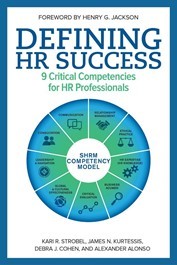 Lastly, if you want to learn more about what it takes to be a successful human resources professional, check out the latest book from the Society for Human Resource Management (SHRM) titled “Defining HR Success: 9 Critical Competencies for HR Professionals.” This book outlines the SHRM competency model for human resources professionals, including the validation study.
Lastly, if you want to learn more about what it takes to be a successful human resources professional, check out the latest book from the Society for Human Resource Management (SHRM) titled “Defining HR Success: 9 Critical Competencies for HR Professionals.” This book outlines the SHRM competency model for human resources professionals, including the validation study.
What I really enjoyed reading this book were the examples that help us in developing HR competencies in particular areas. So, if your goal is to improve critical thinking, there’s a whole list of activities you can do to improve your critical thinking skills. It also shares how to develop a professional development plan. As we start to enter that time of year when we’re thinking about goals and plans and budgets, this is a good resource to help us focus on making ourselves better.
Whether your goal is to get a job in human resources or another department, remember to take a big picture outlook to your career. Fabulous opportunities are available everywhere.
Image courtesy of Sharlyn Lauby
The post Developing HR Competencies – Ask #HR Bartender appeared first on hr bartender.






August 28, 2015
Quick Shots for #HR and #Business Pros – Conference Travel Edition
Mr. Bartender and I just returned from our annual strategy session. Every year we take a little time off during the summer to plan for the next twelve months. We talk about our company, ITM Group, the blog and goals. While many organizations use Q3 and Q4 for budgets, strategies and plans, we’ve found that the summer is best from a scheduling perspective.
Speaking of scheduling, I’m changing up my personal planner for 2016. Last year, I backed a Kickstarter campaign called Passion Planner. I’ve been using it this year and, while it has several features I like a lot (i.e. the good things that happened box is one of my faves), I wanted something different. So I’m embracing my “work hard, play hard” side and going with an Erin Condren planner. I really like the fun designs. If you decide you want a little whimsy in your 2016 calendar, feel free to use this referral code. I think I get something if you make a purchase. 
August 27, 2015
What Happens At the Meeting After the Meeting
(Editor’s Note: Today’s post is an excerpt from my book, “ Essential Meeting Blueprints for Managers .” The book is available on Amazon in hard copy and Kindle , in the iTunes store, and directly from the publisher.”
Yes, it’s true. The meeting after the meeting does exist. It’s not an urban legend.
In fact, the meeting after the meeting (or let’s call it the MATM for short) can actually be more important than the original meeting. Many people think it’s really a big gripe session about the meeting. But a true MATM is very important – it often provides insight into the people and discussions that you usually can’t get during the meeting itself.
As a business professional, you want to be included in the meeting after the meeting. Here are six dynamics to watch for:
#1 The Purpose. Typically, the MATM is part venting and part strategy. Usually, participants are frustrated about something that happened during the meeting (the venting part) and the conversation turns toward brainstorming ways to fix the situation (the strategy part).
A MATM of only griping? Well, that’s just a gripe session. Not to say a gripe session isn’t noteworthy, but it’s beyond the scope of this book. Often gripe sessions are about not communicating something well or not getting proper buy-in. We covered getting buy-in with pitch meetings. Meeting where you discuss strategies to fix something, i.e., make a decision. That’s reason for a “real” meeting.
#2 The Attendees. From an office politics perspective, the individuals who attend a MATM are influencers where this particular matter is concerned. The influencers can change from issue to issue. In each chapter, we’ve talked about power during meetings and who has power based upon the meeting. In most cases, the influencers are those with the most power.
Something to note: try to notice who initiates the MATM. Figure out if they are the person who ultimately is accountable for this issue (and it appears they’re soliciting feedback) OR are they trying to influence the person who is ultimately accountable?
#3 The Timing. Sometimes the MATM is spontaneous and other times, it’s planned. If the influencers happen to be at the same place together, the original meeting might just turn into a conversation. “Hey, what did you think of yesterday’s meeting?” And the conversation starts.
The other way is that someone might plan to get a group together quietly. For example, I invite a couple people to lunch. Either before or during lunch, I say, “Hey, I’ve been thinking about last week’s meeting and wanted to get your thoughts.”
#4 The Location. Often, but not always, the MATM takes a more casual tone. It might be a midmorning coffee run, lunch or drinks after work. I’ve seen a lot of people miss the opportunity to participate in a MATM because it looked like a social event and their opinion is “work is work, and I don’t want to socialize with my co-workers.”
It can be unfortunate because, if you don’t recognize the signs, then you can’t participate. On the other side, I’ve seen organizers of the MATM intentionally choose a venue knowing certain people wouldn’t attend. For example, Carol doesn’t ever join us for happy hour, so let’s meet then.
This is a tough decision. I can’t tell you the right answer. What I can recommend is don’t be naive and believe business only happens in office buildings and boardrooms. It happens everywhere – on golf courses, social networking platforms, at coffee shops and during happy hour.
#5 The Discussion. I mentioned earlier that the MATM can often be a gripe session. If you’re at a MATM, listen carefully to the complaints. Try to understand the frustrations and also why that frustration may or may not have been addressed during the meeting.
The other conversation that happens during a MATM is strategy. What people plan and agree to do next, as a result of the MATM. This can offer valuable insight into what happens behind the scenes in the organization. It can also tell you a lot about the individuals involved and their comfort zones, spheres of influence and workplace power.
#6 The Commitment. There’s an over quoted line from the 1999 movie starring Brad Pitt and Edward Norton called “Fight Club”: “The first rule of Fight Club is: You do not talk about Fight Club.”
The same rule applies here. What people share in the MATM must be respected. The reason MATMs are important and can work well for organizations is because people let their guard down. They talk about what challenges them and they might share something they plan to do. Unless your role in the organization is to go forewarn someone, then you have to respect the tradition of this meeting.
Instead of trying to eradicate the meeting after the meeting, find a way to play a positive role in them. As a human resources professional, I found that, when I was being invited to the meeting after the meeting, it was to help the group in a specific way.
To clarify something. Someone at the meeting didn’t understand something that happened. Instead of asking during the meeting, they might choose to wait until after and ask some questions. They might also choose to ask someone other than the meeting leader.
This can occur a lot with new supervisors and managers, especially when they haven’t had prior exposure to these types of meetings. They need to learn from someone they can trust. This is the part of business that never shows up in the employee handbook or in a training program. Years ago, I had a boss tell me, “Over the years, with each job, I learned a little bit about human resources and a whole lot about office politics.” That line stuck with me. It’s my job as a manager to share the realities of the workplace with others.
To be a sounding board. Participants want to say something, but they don’t know how their comments will be received. They are looking for someone to offer a different perspective. Not approval or support, only a point of view.
This relates to my comment about sharing the realities of work. Books, articles and media will tell you it’s important to be open, honest and share with your boss. This is totally true and I completely agree with it. This doesn’t mean you should be unprepared. Having a sounding board gets you prepared. If you choose the right person, they can help you to potentially see a different point of view.
Bottom line, your reputation and relationships matter. They will help you get a seat at the meeting after the meeting.
Image courtesy of Sharlyn Lauby
The post What Happens At the Meeting After the Meeting appeared first on hr bartender.






August 25, 2015
9 Public Speaking Tips for Your Next Business Presentation
I feel very fortunate that I learned about public speaking early in life. One of my first jobs was being a tour guide at an aquatic marine life theme park who has an Orcinus orca as their mascot. (I’ll let you guess which one!) While I didn’t realize it at the time, the experience was priceless.
After attending a few events lately, I wanted to share a few observations about public speaking. We’ve all heard the old cliché about more people fearing public speaking than death. As business professionals, it’s essential to learn how to speak in front of groups. It’s part of our job. Even if we don’t do it every day. Let me share a couple of examples that might hit home:
At conferences, major sponsors are invited to speak about their company at the podium. Or a volunteer leader is asked to introduce a speaker.
I once worked with a software company that held an annual users conference. During the event, their programmers (i.e. the subject matter experts) would conduct the sessions. The programmers had to not only work on their sessions but also their presentation skills.
Don’t make excuses like “I’m not a professional speaker.” or “I don’t need to learn public speaking.” because someday you might need to do an introduction, a short talk about your company, or a presentation demonstrating your expertise. The next time you’re invited to do any kind of public speaking, here are 9 tips to help you:
PRACTICE! And practice some more. Whether it’s your first for fifty-first presentation, it doesn’t hurt to do a little practice. Review the material. Make sure your PowerPoint works. I like to practice in front of a mirror – it gives me reminders about my posture and body language. I also practice saying the words out loud. Not only does it allow me to get comfortable with the material but I can time myself to see if I’m over/under.
Arrive early and stand in front of the room. And I don’t mean stand there for 30 seconds. Stand there long enough to get comfortable with the surroundings. If the room has a podium, stand behind it for a couple minutes to see how it feels. If the podium is on a riser, stand on it so you know what it feels like to walk up the steps and be on a raised platform. The more comfortable you are, the more you can focus on the content you are sharing.
Test the microphone. The room has a microphone for a reason. People think their voice will project – it doesn’t. When you are supposed to use a microphone and you don’t, you give the audience a reason to stop paying attention to you. Don’t use “Test one, two, three…” When I test a microphone, I try to use a couple of sentences that allows me to get used to the sound of my voice amplified. For instance, “I have a Dalmatian. She likes to eat Pop-Tarts.” I like the sentence because it has a “P” word in it – and I can hear how it sounds.
Don’t say your content is boring. This might seem like a no-brainer. But I can’t tell you how many times I’ve heard someone refer to their material as boring. And it’s only because it might be technical. If you say it, then people will believe it before they even hear you speak. You’re the expert and what you have to say is important. ‘Nuf said.
Put the event hashtag and your Twitter handle on every slide. PowerPoint is at most events these days. Instead of hating it…use it as an opportunity. I was at a conference recently where some of the presenters put their Twitter handle, the conference hashtag and soundbites on their slides. Twitter gold – make it easy for me to Tweet and they get rewarded with their soundbites filling the Twitter stream.
Get a photo. This is a biggie! If there’s an event photographer, find out if you will be photographed and if you can get a copy of the photo. As a business person, a photograph of you standing behind a podium is gold. If there’s no event photographer, ask someone in the front row if they will take a couple photos of you while you’re speaking. Give them your phone. Buy a $5 gift card to Starbucks or Amazon before the event and thank them with it.
Speaker selfies are “in”. If you don’t want to hand over your phone over to someone, do a speaker selfie. Turn your back to the audience, ask them to smile and wave, then snap a photo with them in the background. Or just take a picture of the audience and send it out via social media. It’s a way to get the audience involved and have some fun.
Take your name badge off. Why? See reasons 5 and 6 above.
Have one piece of “filler”. I’ve been to several sessions lately where the speaker has ended early. Not 5-minutes early but 15-20 (and one even 30) minutes early. But I can empathize. It’s happened to me – you anticipate more interaction or questions, etc. Create a safety net by having a piece of extra info. Make it something you know really well that doesn’t need a slide or handout. If you don’t need it, that’s fine – it didn’t make or break the session. But if you notice you have time, share it.
Public speaking is one of those things that gets easier with frequency. And having a few jitters is okay. It’s about focusing on being comfortable with the room so you can showcase your expertise and knowledge.
Got any public speaking advice? Let us know in the comments!
Image courtesy of Sharlyn Lauby
The post 9 Public Speaking Tips for Your Next Business Presentation appeared first on hr bartender.






August 23, 2015
Working Out Your Final Notice – Ask #HR Bartender
We’ve written about notice periods and final paychecks before on HR Bartender. You can find those posts here, here and here. Today’s reader question puts the two of them together in an interesting twist.
An employee gave notice on a weekday advising us that their last day would be four (4) workdays later. In the same email, the employee stated they would not return to the office on their scheduled on-site office date, nor any other day through their last day. We have an arrangement that the employee is to work from the office two set days per week and work from home the other three days. The employee stated they will not come in on their regularly scheduled on-site day because they are scheduling interviews for a new job.
We responded by saying the employee’s last day could in fact then be the following day since it appears they are not able to continue to fulfilling their duties while looking for a new job. The employee gave notice to quit and the company expedited their final day. Do we need to pay them through the last date they gave or their new last day? And when do we need to issue their final paycheck? Thank you.
Whether or not to have an employee work out their notice period is a common question, so I asked Krista M. Cabrera, special counsel at Foley & Lardner LLP. She works in their San Diego office and focuses on discrimination, wrongful termination, harassment and wage and hour matters. I’m delighted she agreed to share her knowledge with us. Please remember that her comments should not be construed as legal advice or as pertaining to any specific factual situations. If you have detailed questions, they should be addressed directly with your friendly neighborhood labor attorney.
From a human resources perspective, we talk about notice periods being critical time for the company to work on finding an employee’s replacement. Is there a legal reason for employees to give notice? And if not a legal reason, is there a business reason?
[Krista] From a legal perspective, in most states employment is at-will and thus the presumption is that no notice is legally required on the part of either the employee or the employer unless the employer and employee have entered into an employment agreement with a final notice provision.
In some circumstances there may be a business reason for a notice requirement. For one, as stated above, final notice periods can give the company time to locate a replacement. Notice provisions also can be helpful if the company requires time to turn around a final paycheck.
Should employers have something in their company handbooks about what is considered an acceptable notice period? Why or why not?
 [Krista] I recommend against a blanket policy requiring notice because it can (and usually will) be interpreted as a contract to pay the employee through the final notice period, whether the employer wants the employee to keep working for the company or not. Usually, the employer does not want an employee who has resigned to stick around and have access to confidential information while probably performing very little work, and thus employers often end up paying the employee for the notice period while the employee does no work.
[Krista] I recommend against a blanket policy requiring notice because it can (and usually will) be interpreted as a contract to pay the employee through the final notice period, whether the employer wants the employee to keep working for the company or not. Usually, the employer does not want an employee who has resigned to stick around and have access to confidential information while probably performing very little work, and thus employers often end up paying the employee for the notice period while the employee does no work.
In this scenario, we don’t know what the company considers an acceptable notice period. Most of the time, we think of two-week notice. If an employee gives less than two-week notice, is there anything the company can do about it?
[Krista] No, there is nothing you can do if the employee is at-will and has no employment contract. On the other hand, if there is an employment contract that addresses a penalty if an employee does not give notice (such as reduced severance) then yes.
I know of industries and positions where the day you give your notice is also considered your last day. It’s mostly because of the competition in the market. The company typically pays out the notice period, although the employee doesn’t come into work. Does the situation change when an employee’s notice is cut short because of performance issues?
[Krista] If the company policy requires an employee who resigns to give final notice, then the company should pay through the notice period, even if there are performance issues. The exception would be where there is a contract or policy stating that notice is inapplicable if there are performance issues. Such a contract or policy would have to clearly define the type of performance issues that would cause a notice payment to be terminated.
We’ve talked about the notice period and determining final pay. When do final paychecks need to be issued?
[Krista] In California and Massachusetts (as well as a number of other states), the company must give the employee the final paycheck on the last day of employment. In California, if an employee quits without final notice, then final pay is due within 72 hours of quitting. In other states like New York and Florida to name a few, the final paycheck must be given by the next regular payroll date.
For more information about issuing final paychecks, visit www.dol.gov. In California, you can go to the DIR website at www.dir.ca..gov
Again, many thanks to Krista for sharing her knowledge. Don’t forget that Foley & Lardner has several blogs so you can keep up with their insights about health care, labor law and more.
I have to admit that I love getting your questions. It’s interesting to see what issues people are dealing with and it’s challenging to find answers. Keep those questions coming! I’m having great fun answering them for you.
Image courtesy of Sharlyn Lauby
The post Working Out Your Final Notice – Ask #HR Bartender appeared first on hr bartender.






August 21, 2015
The Restaurant Industry Trains America’s Workforce – Friday Distraction
(Editor’s Note: Today’s post is brought to you by our friends at the National Restaurant Association Educational Foundation. As the philanthropic foundation of the National Restaurant Association, the NRAEF works to attract, develop and retain professionals for the restaurant industry. Enjoy today’s post!)
A few months ago, I wrote a post about a workforce trend that I was noticing. Professional associations are dedicating resources to talk about the value of having a career in their specific industry. I said it then and I’ll say it again, as the hiring market becomes more challenging, recruiting efforts will get creative. What better way to help organizations recruit than to have their professional association promote the value of careers in their particular industry.
That’s what is happening in the restaurant industry. The National Restaurant Association Educational Foundation (NRAEF) is stepping up for their member organizations and talking about the value of working in the restaurant industry. Brilliant. The NRAEF is also sharing their Food and Beverage Service Competency Model as a way for people to understand what it takes to be successful in the restaurant industry.
NRAEF Service Competency Infographic
What struck me as I looked at the model is that the Tier 1 (personal effectiveness), 2 (academic), and 3 (workplace) skills are those things we look for in most candidates. From a career development perspective, it’s those career entry skills such as teamwork, time management and professionalism. You know, the things that make us a good employee, regardless of job responsibilities or industry.
Did you know the restaurant industry offers one in three American’s their first job? Meaning for one-third of the working world, we learn how to be a great employee because of our experience in the restaurant industry. The good news for this industry is, more than 80% of employees choose to stay in the industry and move to positions of greater responsibility and higher pay. So the investment pays off in employee retention.
The Restaurant Industry Trains America’s Workforce #ChooseRestaurants
Click To Tweet
The NRAEF is setting an example for industries everywhere. Understand what success looks like in your industry, train people to be successful, and then share your story to attract the best talent.
The post The Restaurant Industry Trains America’s Workforce – Friday Distraction appeared first on hr bartender.






Sharlyn J. Lauby's Blog
- Sharlyn J. Lauby's profile
- 10 followers









